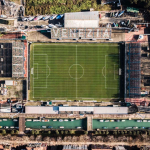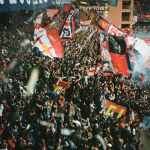
Many coaches are starting to complain about the size of pitches in Serie A
When size matters
January 5th, 2022
Anyone who knows well and has a past or present as a great coach on Football Manager, a football management game with one of the largest databases ever, knows that the beginning of the season is a crucial time, not only for the football market and the consequent definition of the roster, but especially because the coach also has the right to choose the size of the playing field. At first glance it may seem a simple choice, easy, quick and painless, just press a button and that's it, on with what matters most, training and football market. In reality, whether you are the coach of Inter or Nordsjælland, this choice represents a fundamental junction of the season, for the setting of the team and ultimately the game.
Beyond the virtual dimension, the size of the field counts a lot in reality, as Stefano Pioli knows well. During the match against Spezia he brought to light the debate on the size of the Picco, confessing to the microphones that he feared the game because of the width of the field of 65 meters, three smaller than most of the fields of Serie A, which normally reach 68. It is no coincidence that last year Spezia managed to stop Conte's unbeatable Inter at home, making the Picco a real fortress, a ground where they laid the foundations for staying in Serie A. But Spezia are not the only ones, even the Penzo in Venice shares the same dimensions as the Ligurian ground, receiving this year in fact the label of "difficult field". Unlike the Picco, which will be renovated in the next few years, the problem of the Lagunari as well as Cagliari (another field less wide than the average, 67 meters) is precisely the terrain surrounding the stadium that makes it impossible to make even minimal changes to enlarge the playing field, so with the goodness of the coaches those fields will always remain 'difficult'.
Not only the width, but also the length influences the game of a team, a controversy that was not only raised in Italy. When Maurizio Pochettino coached Spurs and because of the work on the new stadium, his team was forced to play at Wembley, he asked the English federation to shorten the pitch from 107 metres to 100. A real sacrilege for the federation, which obviously sent the request back to the sender, because it is not possible to change that pitch, not even temporarily, the symbol par excellence of English football.
For a club that is accustomed to passing the ball around a lot, setting up its play on the wings, preferring a high and suffocating pressing, it is important to have a very long pitch, which can support and bear the running of the wings and the overlapping of the full-backs. It's no coincidence that the pitch at the Stadio Maradona in Naples is the longest in Serie A, stretching about 110 metres, 5 more than the others. It's a perfect rectangle for Spalletti's side, who are used to getting full marks at home, not only because of their warm fans, but also because of their careful handling of the ball and the sudden verticality of their wingers, who have been running freely on those long sides for years, from Callejon and Lavezzi in the past to Lozano and Insigne today.
Even if it seems a trifle, finding oneself on a narrower or wider pitch can disorientate the players and make all the game situations and schemes rehearsed during the week disappear. A problem shared both by those who attack on narrower portions of the pitch and by those who defend, since on a longer pitch they will be forced to review all the defensive dynamics. This is an important discussion carried out by many coaches, especially in Italy, where most of the stadiums were built for the 1990 World Cup and from a structural point of view are more than outdated and antiquated for today's fast and dynamic football.
















